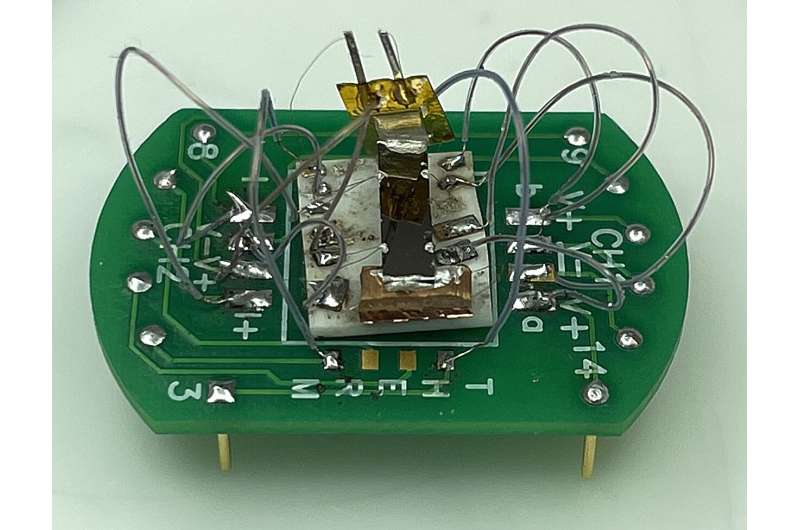
This device tests the properties of the thin layer of cadmium arsenide – the black strip in the center. Credit: UC Santa Barbara
If there’s one thing we humans are good at, it’s producing heat: a significant amount, and in many cases most, of the energy we generate and put into our systems is wasted as heat, whether it’s our devices, transport, our factories, even. our electrical grid.
“Waste heat is everywhere,” said UC Santa Barbara mechanical engineering professor Bolin Liao, who specializes in thermal science and renewable energy. “Our power lines, our car tailpipes — there are so many places where we create excess waste heat.”
At the moment, we are quite limited in how we can make the most of this dissipating heat. But Liao and UCSB colleagues, along with collaborators from Ohio State University and the University of Hong Kong, are making progress toward harnessing that heat, with the first comprehensive characterization of the thermoelectric properties of cadmium arsenide thin films high quality.
“If we could harvest that lost heat, then that would be fantastic,” he said. “That would really increase our energy efficiency, and it’s also a really sustainable energy source.”
The team’s research is published in the journal Advanced Materials.

A diagram of the surface topological state versus the bulk state of cadmium arsenide and the thin film performance versus the state-of-the-art material, bismuth telluride. Credit: UC Santa Barbara
A better thermoelectric material
“To get high efficiency, we need the material to conduct electricity well, conduct heat poorly, and generate a high voltage for a given temperature change,” Liao said. Poor thermal conductivity minimizes heat dissipation while maintaining a temperature difference across the material, resulting in an electrical current enhanced by the material’s high performance electrical conductivity. The voltage resulting from a temperature gradient is known as the Seebeck effect.
This combination of electrical and thermal transport properties is ideal, but according to Liao, “very difficult to achieve in practice.”
Enter cadmium arsenide (Cd3like2), a Dirac semimetal with promising transport properties, in particular, a low thermal conductivity and high electron mobility.
“We were very excited about this material and thought, ‘Okay, this is really a combination of these two great properties,'” Liao said. “But there’s just one problem. That problem was that in addition to good electrical conductivity and poor thermal conductivity, you also need this material to be able to generate enough voltage under a temperature gradient.”
As a semimetal, cadmium arsenide is excellent at conducting electricity very quickly, but generates only a very small Seebeck voltage. To create a useful voltage, Liao explained, a band gap must be opened.
“You want this material to have a certain energy range where electrons can’t conduct. This is called a band gap,” he said. Because of the gap, which essentially blocks the free flow of electrons, enough electrical “pressure” (aka voltage) can build up in response to a temperature change across the material. In most cadmium arsenide crystals, there is no band gap.
Fortunately, the team had an advantage, in the form of UCSB materials scientist Susanne Stemmer’s thin-film skills. With expertise in molecular beam epitaxy (MBE), Stemmer’s lab is able to “grow”, molecule by molecule, high-quality materials with thicknesses ranging from a few nanometers to a few micrometers. This is particularly useful in the case of cadmium arsenide, it turns out, as there are properties on the surface of the material that are distinct from those in the bulk of the crystal.
“A signature of topological insulators like this is that in addition to electron conduction states within the bulk material, they have surface conduction channels,” Liao explained. “There are electrons that just sit on the surface of the material and they can conduct electricity.”
To set the stage for these topological effects, the Stemmer Lab created three high-quality MBE-grown films of different thicknesses: 950 nm, 95 nm, and 25 nm.
“The high mobilities of epitaxial cadmium arsenide films allow their topological nature to be revealed through quantum transport measurements,” explained Stemmer.
The team found that the thinner the material, the more evidence there was for a band gap. And, the thinner the material, the more surface effects dominate.
“Essentially, if you go to very low dimensions, quantum mechanics starts to play a role, and you can open a band gap just by reducing the size,” Liao said, due to a phenomenon known as quantum confinement. They also found that the thinner the material, the higher the thermoelectric sensitivity (known as the Seebeck coefficient), resulting in more voltage in response to the temperature gradient, a response increased by seven times compared to the latest material. .
These quantum effects were found at near-zero temperatures, so although currently Cd3like2 Thin films can’t be deployed for room-temperature or high-thermal-efficiency applications, Liao said, and may be more useful in cryogenic environments, which exist in many applications, such as aerospace, medicine and quantum computing.
“If you’re using a very efficient, solid-state cooling material, you won’t need dangerous, polluting refrigerants,” he said.
“Practically, it’s a very useful discovery for low-temperature, cryogenic, solid-state cooling,” he added, “but fundamentally, this work is more important because we demonstrate for the first time that this confinement effect can improve some thermoelectric properties, and also for the first time we isolated the contribution from surface states.”
More information:
Wenkai Ouyang et al, Remarkable thermoelectric properties of topological surface states in quantum-confined Cd3As2 thin films, Advanced Materials (2024). DOI: 10.1002/adma.202311644
Provided by University of California – Santa Barbara
citation: First comprehensive characterization of extraordinary thermoelectric properties of cadmium arsenide thin films (2024, June 27) Retrieved June 28, 2024 from https://phys.org/news/2024-06-comprehensive-characterization-extraordinary- permoelectric.htmlpro
This document is subject to copyright. Except for any fair agreement for study or private research purposes, no part may be reproduced without written permission. The content is provided for informational purposes only.
#comprehensive #characterization #remarkable #thermoelectric #properties #cadmium #arsenide #thin #films
Image Source : phys.org
